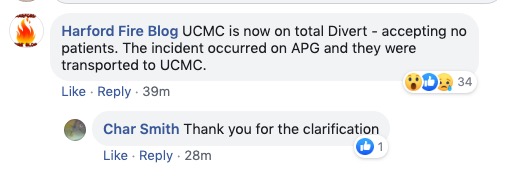
New patients were temporarily diverted from Upper Chesapeake Medical Center in Bel Air, Maryland due to one person being sent there for treatment after they were exposed to a nerve agent at the Aberdeen Proving Ground. According to Harford County’s EMS public information office, there is no immediate threat to the community. It’s not yet known what chemical the patient was exposed to or how, but they are reported to be in stable condition and the hospital is no longer diverting patients. Here is what we know so far.
Details came in slowly about exactly what was happening after UCMC stopped accepting new patients. Harford County Maryland Fire & EMS’ public information office shared an official update on Facebook. They wrote: “6/22 1:39 p.m. The Bel Air Fire Company and Harford County Hazmat team is currently at Upper Chesapeake Medical Center in reference to a patient exposed to a chemical on APG. The single patient is being evaluated and there is no immediate threat to the community. Upper Chesapeake Hospital is currently not accepting any patients. APG is the primary agency and their media affairs office is handling this incident. JC/RG”
Harford County’s EMS page emphasized that there is no immediate threat to the community, and a single person is being evaluated at the hospital.
CBS Baltimore reported that the person exposed to the nerve agent was taken to the hospital after being decontaminated at the base and is currently in stable condition. More people may have been exposed to the unnamed chemical, but they did not need to be taken to the hospital.
CBS Baltimore also noted that UCMC has returned to normal activities and is no longer diverting patients.
Harford County’s PIO Page issued an update at 3:43, sharing that all units had cleared from the hospital and one patient was still being evaluated at UCMC.
Initial reports indicated that as many as three people might have been exposed to the undisclosed nerve agent, but it now appears that it was just one person. Their current status and the type of nerve agent is not yet known.
The initial nerve agent exposure was at the Army’s nearby Aberdeen Proving Ground, not at the hospital itself.
UCMC was placed on total divert after the person exposed was transported there, Harford Fire Blog noted.
Additional decontamination units were requested and the hospital was on “total divert,” which means that new patients were being diverted to other nearby hospitals. The hospital has since returned to normal operations, CBS Baltimore updated.
Tara Elise shared the following photos on Facebook from the hospital, in response to Harford Fire Blog’s update:
Aberdeen Proving Ground is a U.S. Army facility located next to Aberdeen, Maryland in Harford County. It’s the Army’s oldest active proving ground. In 2003, The Baltimore Sun referred to Aberdeen as being the third most expensive base cleanup in the United States. It has been the source of experiments for many chemical weapons, along with small arms testing. In 2003 the Sun said there were still unexploded projectiles with mustard agent and other chemical agents on Aberdeen’s creek banks.
The U.S. Army Combat Capabilities Development Command Chemical Biological Center, focusing on chemical biological research and development, is located at four sites including Aberdeen.
Aberdeen Proving Ground is also home to 79 bald eagle nests and 117 bald eagle chicks that they are currently tracking.
Aberdeen Proving Ground’s current mission, according to their website, is: “to provide test and test support services for authorized customers, within DoD and outside DoD, including government and non-government organizations, domestic and foreign. Provide comprehensive test and training both real and simulated; provide expert knowledge and technical services including instrumentation application, facility operations, manufacturing and fabrication; exploit emerging technologies; and develop leading edge instrumentation and test methodologies.”
APG has a Facebook page that can be followed here.
This is a developing story.




